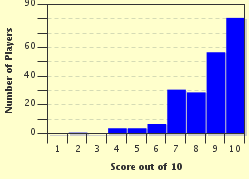Quiz Answer Key and Fun Facts
1. Which queen of Egypt was known for her beauty and being the mother of King Tut?
2. This Egyptian queen known for her numerous love affairs with men such as Julius Caesar and Marc Antony. Who is she?
3. This next woman was the Duchess of Aquitaine, Queen of England, and Queen of France. Who is she?
4. This French general was the leader of the French army for a time in the Hundred Years' War before being executed for witchcraft by the English. Who was she?
5. Who was the Queen of Spain that launched the Inquisition, torturing and killing many people for allegedly insincere conversion to Christianity?
6. This Queen of France, consort to King Henry II, was from the de Medici family. What was her name?
7. Which queen of England was known as "the Virgin Queen"?
8. Mbande Nzinga was a queen of a kingdom in which continent?
9. Who was the first female Prime Minister of Israel?
10. Who was the first woman on the United States Supreme Court?
Source: Author
foil7
This quiz was reviewed by FunTrivia editor
bloomsby before going online.
Any errors found in FunTrivia content are routinely corrected through our feedback system.

